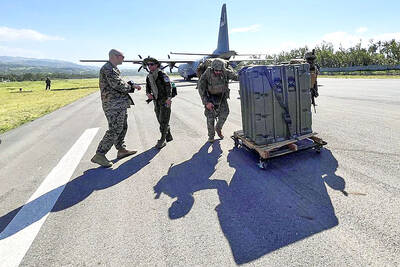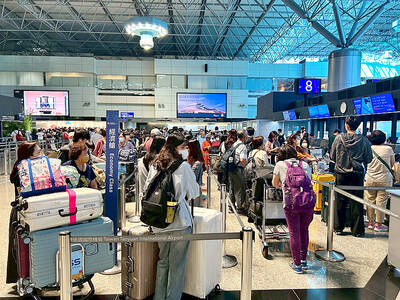A new domestic travel subsidy program beginning tomorrow aims to encourage 7.22 million people to travel, the Tourism Bureau said yesterday, adding that the scheme would create NT$31.4 billion (US$1.05 billion) in economic value.
The subsidy program, which is to run until Dec. 15, subsidizes group tours arranged by travel agencies, as well as independent travelers and visitors to amusement parks, the bureau said.
A group tour can receive a subsidy of up to NT$30,000 on condition that it has at least 15 members, lasts for at least two days and falls mostly on weekdays, in addition to other requirements set by the bureau.

Photo: Chen Hsin-yu, Taipei Times
Independent travelers would be eligible to apply for a subsidy of NT$800 per room, or up to NT$1,300 per room for travelers who have had a booster shot of a COVID-19 vaccine, for stays in hotels recommended by the bureau, it said.
Amusement park visitors can receive discounts of at least 70 percent through the program, the bureau said.
The program is funded by the government’s Forward-looking Infrastructure Development Program. Of the NT$6 billion earmarked for the Ministry of Transportation and Communications, NT$5.5 billion would be allocated to the Tourism Bureau to support the domestic travel industry, while NT$500 million would support the highway bus system.
The tourism industry has gone through a difficult time over the past two years due to the COVID-19 pandemic, Minister of Transportation and Communications Wang Kwo-tsai (王國材) told a news conference in Taipei.
“However, we are in the phase of gradually reopening the nation’s borders and preparing to resume normal life. Before the government starts issuing tourist visas to international visitors, we want to use this period to revive domestic tourism,” Wang said. “This should be considered a warm-up exercise for tourism operators, as international visitors are coming [soon].”
Domestic tourism should be the pillar of the nation’s tourism sector, Wang said.
About 80 to 90 percent of domestic travelers engage in one-day tours and many do not know how to make tour arrangements, he said.
Travel agencies should find ways to have tourists spend more days on domestic tours, Wang said, adding that they should also offer tours to attract international travelers and motivate them to visit Taiwan repeatedly.
Wang said he was not too worried about the budget, which could deplete quickly.
“The most important goal of the program is to introduce quality tours of scenic spots in Taiwan to travelers,” Wang said. “In the next five months, borders are expected to gradually reopen and more international visitors are expected to arrive. As we return to normal life, we should aim to generate tourism revenues by attracting more visitors to Taiwan.”
Of the NT$5.5 billion to be used to revitalize domestic tourism, about NT$2 billion will be given to travel agencies, NT$2 billion to hotel and accommodation operators, and NT$400 million to amusement park operators, Tourism Bureau Director-General Chang Shi-chung (張錫聰) said.
The bureau has also selected six “charming tourist destinations” to market to international travelers: the north coast, the northeast coast, the east coast, Sun Moon Lake (日月潭), Alishan (阿里山) and the Penghu islands, Chang said.
In addition to a tourism exchange conference with South Korea this month, Taiwan would have two other tourism exchange conferences with Japan and Vietnam in September and October respectively, Chang said.

Three batches of banana sauce imported from the Philippines were intercepted at the border after they were found to contain the banned industrial dye Orange G, the Food and Drug Administration (FDA) said yesterday. From today through Sept. 2 next year, all seasoning sauces from the Philippines are to be subject to the FDA’s strictest border inspection, meaning 100 percent testing for illegal dyes before entry is allowed, it said in a statement. Orange G is an industrial coloring agent that is not permitted for food use in Taiwan or internationally, said Cheng Wei-chih (鄭維智), head of the FDA’s Northern Center for

The Chinese military has built landing bridge ships designed to expand its amphibious options for a potential assault on Taiwan, but their combat effectiveness is limited due to their high vulnerability, a defense expert said in an analysis published on Monday. Shen Ming-shih (沈明室), a research fellow at the Institute for National Defense and Security Research, said that the deployment of such vessels as part of the Chinese People’s Liberation Army (PLA) Navy’s East Sea Fleet signals a strong focus on Taiwan. However, the ships are highly vulnerable to precision strikes, which means they could be destroyed before they achieve their intended

LOOKING NORTH: The base would enhance the military’s awareness of activities in the Bashi Channel, which China Coast Guard ships have been frequenting, an expert said The Philippine Navy on Thursday last week inaugurated a forward operating base in the country’s northern most province of Batanes, which at 185km from Taiwan would be strategically important in a military conflict in the Taiwan Strait. The Philippine Daily Inquirer quoted Northern Luzon Command Commander Lieutenant General Fernyl Buca as saying that the base in Mahatao would bolster the country’s northern defenses and response capabilities. The base is also a response to the “irregular presence this month of armed” of China Coast Guard vessels frequenting the Bashi Channel in the Luzon Strait just south of Taiwan, the paper reported, citing a

About 4.2 million tourist arrivals were recorded in the first half of this year, a 10 percent increase from the same period last year, the Tourism Administration said yesterday. The growth continues to be consistent, with the fourth quarter of this year expected to be the peak in Taiwan, the agency said, adding that it plans to promote Taiwan overseas via partnerships and major events. From January to June, 9.14 million international departures were recorded from Taiwan, an 11 percent increase from the same period last year, with 3.3 million headed for Japan, 1.52 million for China and 832,962 to South Korea,